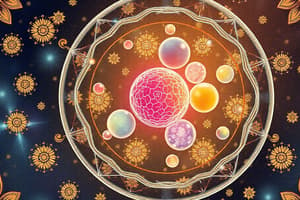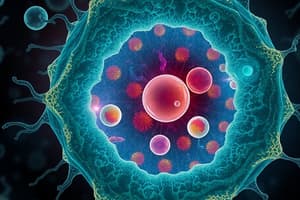Podcast
Questions and Answers
What is the primary function of the nuclear membrane?
What is the primary function of the nuclear membrane?
- To regulate the synthesis of ribosomes
- To facilitate cell division
- To surround and protect the nucleus (correct)
- To store DNA
Which component of the nucleus is responsible for ribosome synthesis?
Which component of the nucleus is responsible for ribosome synthesis?
- Nucleolus (correct)
- Nucleoplasm
- Nuclear pore
- Chromatin
What is the primary composition of chromatin?
What is the primary composition of chromatin?
- Proteins and ribosomes
- RNA and lipids
- Nucleotides and amino acids
- DNA and histones (correct)
What type of chromatin is described as less compact and frequently expressed?
What type of chromatin is described as less compact and frequently expressed?
During which phase does the nucleolus lose its identity?
During which phase does the nucleolus lose its identity?
What is found within the nucleoplasm?
What is found within the nucleoplasm?
How does chromatin change during cell division?
How does chromatin change during cell division?
What structure allows selective exchange between nucleoplasm and cytoplasm?
What structure allows selective exchange between nucleoplasm and cytoplasm?
What structures are nucleosomes primarily composed of?
What structures are nucleosomes primarily composed of?
Which of the following describes the primary function of the nucleus in a eukaryotic cell?
Which of the following describes the primary function of the nucleus in a eukaryotic cell?
What type of cells are characterized as anucleated?
What type of cells are characterized as anucleated?
What is the role of transcription factors within the nucleus?
What is the role of transcription factors within the nucleus?
Which of the following represents a characteristic of multinucleated cells?
Which of the following represents a characteristic of multinucleated cells?
Which enzymes are primarily involved in the transcription process within the nucleus?
Which enzymes are primarily involved in the transcription process within the nucleus?
What is the structure formed by the coiling of nucleosomes?
What is the structure formed by the coiling of nucleosomes?
Which type of chromosomal structure is primarily observed during metaphase?
Which type of chromosomal structure is primarily observed during metaphase?
What is the primary function of ribosomes in cells?
What is the primary function of ribosomes in cells?
Which condition is linked to a defect in ribosomal function?
Which condition is linked to a defect in ribosomal function?
What components are found in a mitochondrion?
What components are found in a mitochondrion?
Which part of the mitochondrion is primarily responsible for producing ATP?
Which part of the mitochondrion is primarily responsible for producing ATP?
What is the significance of the equation C6H12O6 + O2 → CO2 + H2O + ENERGY (ATP)?
What is the significance of the equation C6H12O6 + O2 → CO2 + H2O + ENERGY (ATP)?
Which of the following statements accurately describes the outer mitochondrial membrane?
Which of the following statements accurately describes the outer mitochondrial membrane?
What role do special carriers play in the inner mitochondrial membrane?
What role do special carriers play in the inner mitochondrial membrane?
How many children are estimated to be affected by dyskeratosis congenita related to ribosomal disorders?
How many children are estimated to be affected by dyskeratosis congenita related to ribosomal disorders?
What is the primary function of the cis face of the Golgi apparatus?
What is the primary function of the cis face of the Golgi apparatus?
What consequence can occur if there is a defect in the Golgi apparatus's function?
What consequence can occur if there is a defect in the Golgi apparatus's function?
Which type of disorders can result from defects in the Golgi apparatus?
Which type of disorders can result from defects in the Golgi apparatus?
Which process is primarily responsible for lysosomal enzyme synthesis?
Which process is primarily responsible for lysosomal enzyme synthesis?
What is the role of the membrane of lysosomes?
What is the role of the membrane of lysosomes?
How do products from the Golgi apparatus typically reach their destinations?
How do products from the Golgi apparatus typically reach their destinations?
What is one of the key biomedical importances of the Golgi complex?
What is one of the key biomedical importances of the Golgi complex?
What types of storage do Golgi apparatus products include?
What types of storage do Golgi apparatus products include?
What is the primary role of mitochondrial DNA?
What is the primary role of mitochondrial DNA?
What is a consequence of the high mutation rate in mitochondrial DNA?
What is a consequence of the high mutation rate in mitochondrial DNA?
Which statement accurately describes peroxisomes?
Which statement accurately describes peroxisomes?
How do the sizes of peroxisomes vary among different cell types?
How do the sizes of peroxisomes vary among different cell types?
What initial symptoms are commonly associated with mitochondrial deficiency diseases?
What initial symptoms are commonly associated with mitochondrial deficiency diseases?
Which of these statements about peroxisomes is false?
Which of these statements about peroxisomes is false?
Why are skeletal muscle fibers particularly sensitive to mitochondrial defects?
Why are skeletal muscle fibers particularly sensitive to mitochondrial defects?
What best describes the function of enzymes within peroxisomes?
What best describes the function of enzymes within peroxisomes?
Flashcards are hidden until you start studying
Study Notes
The Nucleus
- The nucleus is a membrane-bound organelle found in eukaryotic cells.
- It contains the cell's genetic material in the form of DNA.
- The nucleus is responsible for controlling and regulating cellular activities.
Nuclear Membrane
- The nuclear membrane is a double-layered structure that surrounds the nucleus.
- It protects the nucleus and its contents.
- The nuclear membrane contains nuclear pores that allow the transport of molecules between the nucleus and the cytoplasm.
Nucleoplasm
- Nucleoplasm is the liquid within the nucleus.
- It is similar to the cytosol within the cytoplasm.
- It contains enzymes, proteins, and other molecules necessary for nuclear function.
Nucleolus
- The nucleolus is a sub-organelle within the nucleus.
- It is the site of ribosome synthesis.
- It is composed of rRNA and proteins.
- The nucleolus disappears during cell division and reforms afterward.
Chromatin and Chromosomes
- Chromatin is made up of DNA wrapped around proteins called histones
- Euchromatin is less compact DNA and contains genes that are frequently expressed by the cell.
- Heterochromatin is more compact DNA and contains genes that are not expressed by the cell.
- Chromatin condenses into chromosomes during cell division, making them visible under a microscope.
- This process helps to ensure that each daughter cell receives a complete set of chromosomes.
Chromosomes
- Each human cell contains 46 chromosomes (except sperm or egg cells).
- During cell division, chromosomes condense into visible structures.
Anucleated and Polynucleated Cells
- Anucleated cells lack a nucleus and are therefore incapable of dividing, such as red blood cells.
- Polynucleated cells have multiple nuclei, such as skeletal muscle cells.
Functions of the Nucleus
- The nucleus stores DNA and directs the cell's activities.
- It is involved in DNA replication and repair.
- It is the site of transcription, where DNA is transcribed into RNA.
- The nucleus contains enzymes involved in regulating transcription, such as RNA polymerases and transcription factors.
Ribosomes
- Ribosomes are small organelles responsible for protein synthesis.
- There are two types: free ribosomes and bound ribosomes.
- Ribosomes can be found in the cytoplasm or attached to the endoplasmic reticulum (ER).
- Bound ribosomes are associated with proteins that are packed in certain organelles or exported from the cell.
Endoplasmic Reticulum (ER)
- The ER is a network of interconnected membranes within the cytoplasm.
- It is responsible for the synthesis and transport of proteins and lipids.
- There are two types of ER: rough ER and smooth ER.
Rough ER
- Rough ER has ribosomes attached to its surface.
- It is involved in the synthesis of proteins.
- It is responsible for the packaging and transport of proteins.
Smooth ER
- Smooth ER lacks ribosomes.
- It is involved in the synthesis of lipids and steroids.
- It is responsible for the detoxification of harmful compounds.
- And plays a role in calcium storage and release.
Golgi Apparatus
- The Golgi apparatus is a stack of flattened, membrane-bound sacs called cisternae.
- It is responsible for processing, packaging, and sorting proteins and lipids.
- One side (cis face) receives products from the ER, and the other side (trans face) ships them out.
- The Golgi apparatus modifies, packages, and prepares products for "shipment" in vesicles to other sites.
- It contributes to the formation of lysosomes and vacuoles.
Lysosomes
- Lysosomes are membrane-bound organelles that contain digestive enzymes.
- They are responsible for the breakdown of cellular debris, damaged organelles, and ingested substances.
- Lysosomes have an important role in recycling cellular components and defending the cell from pathogens.
Mitochondria
- Mitochondria are the powerhouses of the cell.
- They are responsible for producing energy in the form of ATP through cellular respiration.
- Mitochondria have a double membrane.
- They contain their own DNA and ribosomes and are able to replicate independently.
Peroxisomes
- Peroxisomes are small, membrane-bound organelles that contain enzymes involved in various metabolic processes.
- They are involved in the breakdown of fatty acids and the detoxification of harmful compounds.
- Like mitochondria, they can replicate independently.
Disorders of Ribosomes, Mitochondria, and Peroxisomes
- Defects in the function of these organelles can lead to a variety of diseases, such as anemia, cartilage hair hypoplasia, and muscular dystrophy.
- Mitochondrial diseases are often characterized by muscular dysfunction.
- Peroxisome disorders can affect a variety of metabolic pathways, leading to neurodevelopmental problems, liver disease, and other complications.
Studying That Suits You
Use AI to generate personalized quizzes and flashcards to suit your learning preferences.



